Three farms at forage field day give insight into annual forages and hay fertilization rates
Growers learned about small grain and forage pea combinations for dairy feed, hay fertilization on a shoestring budget and advantages and challenges of including other annual forages in feed production program.

Nineteen farmers and six agency representatives attended the Michigan State University Extension Forage Field Day in Rudyard, Michigan, on July 24, 2015. The weather was fine and hay making was in full swing in eastern Upper Peninsula, limiting the participation of area farmers. However, MSU state forage specialist Kim Cassida was able to attend.
The field day consisted of visits to three Rudyard area farms, Folkersma dairy farm, Berkompas farms and the Love farm. Each of these host farms agreed to set up demonstrations based on their own forage interests. Soils in the Rudyard area are mostly flat, red clays and naturally very low in phosphorus and potassium. Timothy/trefoil/clover hay, oats and barley are the predominant crops. Cow-calf, dairy, sheep and hay production are the main farm types in the area. A 2014 forage discussion group convened by MSU Extension identified many forage-related issues, including interest in more local test plot demonstrations. Upper Peninsula MSU Extension educators Frank Wardynski, Stan Moore, Katelyn Thompson and I, along with Cassida, responded by planning a series of on-farm demonstrations and pasture walks across the U.P., with financial support from the MSU Extension.
Site 1: Folkersma dairy farm
The Folkersma dairy farm recently began raising corn silage and triticale/forage peas for high quality dairy ensiled forage. Pea/small grain mixtures aren’t a new invention, but they have not been commonly grown in this part of Michigan. The Folkersma brothers have had success with triticale and peas in recent years. For the demonstration, oat/pea and barley/pea strips were added.
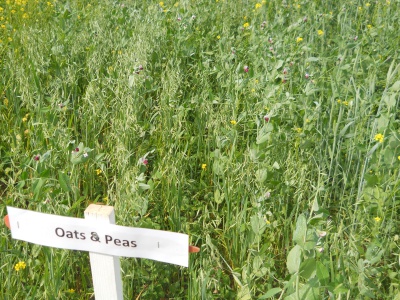
Oats/peas strip demonstration on Folkersma farm.
Site 2: Berkompas farm
The Berkompas farm custom raises dairy heifers for other dairy farms. The forage component of their ration consists mostly of timothy/trefoil/clover hay and balage. Quite a lot of hay ground is available without enough manure to go around. A hay field that has not received manure or fertilizers for a number of years was selected for a non-replicated, side-by-side demonstration of lime and fertilizer application. Two lime rates were compared including no lime, and 1 ton per acre applied on the surface (not incorporated). Three fertilizer rates were used, including:
- No fertilizer.
- Phosphorus and potassium at “nutrient removal” rate plus 50 pounds nitrogen per acre, calculated at a yield goal of 2 tons dry matter per acre using MSU Extension bulletin E2904, “Nutrient Recommendations for Field Crops in Michigan.”
- MSU “build-up” fertilizer rate for phosphorus and potassium plus 50 pounds nitrogen per acre based on an MSU soil test report.
The field day was held before the hay was cut to demonstrate dramatic visual differences between fertilizer treatments. Follow-up yield checks were conducted, showing large yield increase as a result of the fertilizer applications.
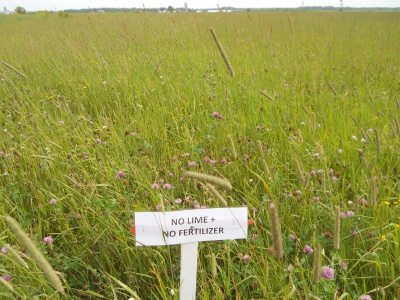
No lime or fertilizer.
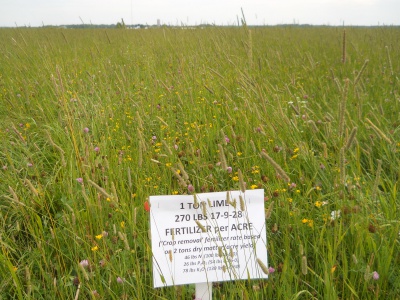
One ton time plus “nutrient removal” fertilizer rate of 270 pounds per acre of 17-9-28.
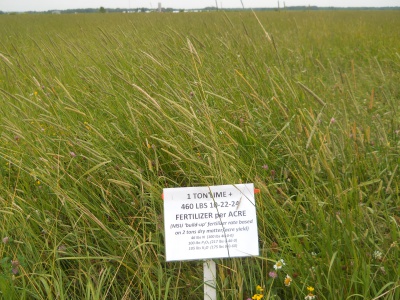
One ton time plus “build-up” fertilizer rate of 460 pounds per acre of 10-22-24.
Site 3: Love farm
The Love farm has an ongoing interest in increased forage tonnage per acre. Instead of harvesting many low-yielding acres over a large area, Bob Love would rather invest money and time to get more forage on fewer acres. The field day focus on his farm was the impact of last year’s annual crop/cover crop strips on the current small grain crop, and use of mixtures of adapted annual forages for high yielding grazing crops. The group viewed a mixed pasture of triticale, hairy vetch, oilseed radish and kale and another of brown midrib sorghum, grass, vetch and clover.
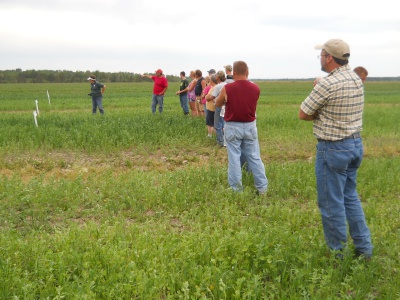
MSU Extension forage specialist Kim Cassida and host farmer Bob Love discuss differences in grain/pea mixtures following cover crops.
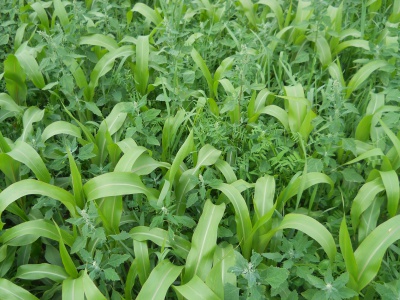
Annual forage mixture of brown midrib sorghum, hairy vetch, clover, grass and common lambsquarters.
Host farmers shared experiences and lessons learned at each demonstration site. Cassida offered comments and insights and responded to questions from the group. Participants indicated that the demonstrations were valuable and provided a great hands-on learning opportunity. The Chippewa County Farm Bureau co-sponsored the meeting and provided refreshments.
A separate article will discuss results of the hay fertilizer and lime demonstration.
For more information about the Chippewa County Forage Field Day or other Upper Peninsula crop-related Extension activities, contact me at isleibj@anr.msu.edu or 906-387-2530.



 Print
Print Email
Email




